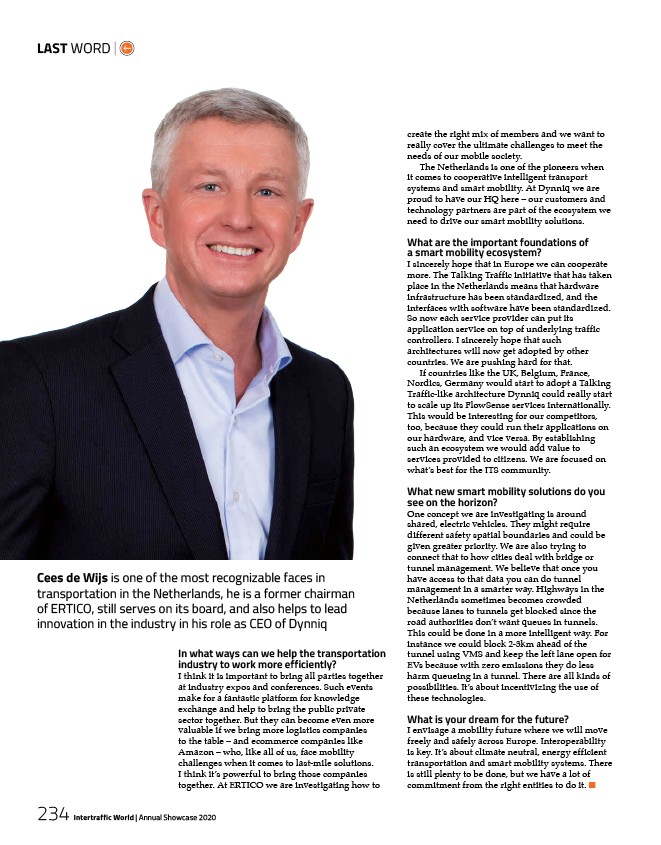
LAST WORD |
Cees de Wijs is one of the most recognizable faces in
transportation in the Netherlands, he is a former chairman
of ERTICO, still serves on its board, and also helps to lead
innovation in the industry in his role as CEO of Dynniq
234
In what ways can we help the transportation
industry to work more efficiently?
I think it is important to bring all parties together
at industry expos and conferences. Such events
make for a fantastic platform for knowledge
exchange and help to bring the public private
sector together. But they can become even more
valuable if we bring more logistics companies
to the table – and ecommerce companies like
Amazon – who, like all of us, face mobility
challenges when it comes to last-mile solutions.
I think it’s powerful to bring those companies
together. At ERTICO we are investigating how to
Intertraffic World | Annual Showcase 2020
create the right mix of members and we want to
really cover the ultimate challenges to meet the
needs of our mobile society.
The Netherlands is one of the pioneers when
it comes to cooperative intelligent transport
systems and smart mobility. At Dynniq we are
proud to have our HQ here – our customers and
technology partners are part of the ecosystem we
need to drive our smart mobility solutions.
What are the important foundations of
a smart mobility ecosystem?
I sincerely hope that in Europe we can cooperate
more. The Talking Traffic initiative that has taken
place in the Netherlands means that hardware
infrastructure has been standardized, and the
interfaces with software have been standardized.
So now each service provider can put its
application service on top of underlying traffic
controllers. I sincerely hope that such
architectures will now get adopted by other
countries. We are pushing hard for that.
If countries like the UK, Belgium, France,
Nordics, Germany would start to adopt a Talking
Traffic-like architecture Dynniq could really start
to scale up its FlowSense services internationally.
This would be interesting for our competitors,
too, because they could run their applications on
our hardware, and vice versa. By establishing
such an ecosystem we would add value to
services provided to citizens. We are focused on
what’s best for the ITS community.
What new smart mobility solutions do you
see on the horizon?
One concept we are investigating is around
shared, electric vehicles. They might require
different safety spatial boundaries and could be
given greater priority. We are also trying to
connect that to how cities deal with bridge or
tunnel management. We believe that once you
have access to that data you can do tunnel
management in a smarter way. Highways in the
Netherlands sometimes becomes crowded
because lanes to tunnels get blocked since the
road authorities don’t want queues in tunnels.
This could be done in a more intelligent way. For
instance we could block 2-3km ahead of the
tunnel using VMS and keep the left lane open for
EVs because with zero emissions they do less
harm queueing in a tunnel. There are all kinds of
possibilities. It’s about incentivizing the use of
these technologies.
What is your dream for the future?
I envisage a mobility future where we will move
freely and safely across Europe. Interoperability
is key. It’s about climate neutral, energy efficient
transportation and smart mobility systems. There
is still plenty to be done, but we have a lot of
commitment from the right entities to do it. n